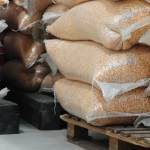What is the Glycemic Index of Feed and How is It Determined Equine
Glycemic Index Among Horse Feeds

You've probably heard the term "glycemic index" at some point. This buzz-phrase has been circulating among informed horse owners for several years, but what does it mean? More importantly, why is it important in equine nutrition?
Glycemic index is a system used to rank carbohydrates based on their effect on blood glucose levels. Devised by Canadian scientists in the early 1980s, the system compares available carbohydrates gram for gram in individual feedstuffs, providing a numerical, evidence-based index of the level of glucose in the blood after a meal, known also as postprandial glycemia.
Though originally developed for humans, the system has been modified and proven reliable for horses. Carbohydrates that break down quickly during digestion have the highest glycemic indices. On the opposite end of the spectrum, carbohydrates that break down slowly, releasing glucose gradually into the bloodstream, have the lowest glycemic indices. A lower glycemic index suggests a slower rate of digestion of sugars and starches in the foods. A lower glycemic response is believed to create a lower insulin demand, better long-term blood glucose control, and a reduction in blood lipids.
In humans, the measurement of blood glucose and insulin response is used to assess the effect of food processing on starch digestion. Starchy foods were classified over the entire range from low to high glycemic and insulin response. The resulting glycemic or insulinemic index utilized white bread as the standard source against which all other foods were compared. A similar ranking has been established for horses based on studies performed at Kentucky Equine Research (KER). Both cereal grains and forages are included in the table. The values shown in Table 1 are estimates provided for the sake of comparison and may differ according to individual studies.
Table 1. Glycemic index (GI) of equine feeds and forages.
Feed Glycemic Index
Sweet feed……………………………………………………………129
Whole oats……………………………………………………………100
Beet pulp and molasses ……………………………………….94
Cracked corn …………………………………………………………90
Beet pulp (unrinsed) ……………………………………………72
Orchard grass hay ………………………………………………..49
Rice bran ……………………………………………………………….47
Ryegrass hay …………………………………………………………47
Alfalfa hay …………………………………………………………….46
Beet pulp (rinsed)………………………………………………….34
Bluestem hay …………………………………………………………23
Oats are used as the standard source among common equine feedstuffs. A feed with a value over 100 produces more blood glucose in a given amount of time than oats; one with a value under 100 produces less. Of the cereal grains commonly fed to horses, oats are considered to have the most readily digested starch content. Corn is lower and barley has the hardest starch to digest.
To use this knowledge in everyday feed management, remember that horses are healthiest when fed diets that can be digested and absorbed slowly. This is because their digestive systems are set up to handle small frequent deliveries of forage throughout each day, as if the horses were grazing. Meals consisting of textured or pelleted concentrates often contain large amounts of starch. Overwhelming the gastrointestinal system with starch will inevitably cause spikes in blood glucose, which may cause problems in individual horses.
Another risk of feeding large concentrate meals revolves around the digestive capacity of the small intestine. Certain horses require large concentrate meals in order to maintain moderate body condition. However, it is sometimes impossible for the small intestine to properly digest the bulk of a large concentrate meal, resulting in some starch passing undigested through the small intestine. This sets the stage for colic, laminitis, and hindgut acidosis.
Interestingly, processing certain cereal grains can dramatically alter glycemic response. Researchers at KER studied the effects of corn processing on glycemic response and found steam-treating corn will increase the glycemic index significantly as the pre-cecal starch digestibility is improved. This reduces the amount of starch likely to bypass the small intestine and enter the hindgut undigested, thus reducing the risk of hindgut acidosis.
Rations with a low glycemic index are popular management tools for horses diagnosed with conditions such as pituitary pars intermedia dysfunction (PPID; equine Cushing's disease), equine metabolic syndrome (EMS), recurrent exertional rhabdomyolysis (RER), polysaccharide storage myopathy (PSSM), and osteochondritis dissecans (OCD). Though horses with these syndromes all benefit from rations with a low glycemic index, the most appropriate form of energy supplementation depends on the disorder and the individual's energy requirement.
Horses with PPID are insulin insensitive and need a ration with a low glycemic index, but their energy requirements may vary. Some may be relatively easy keepers and benefit from mostly forage rations, while others may need extra calories in the form of fat and fermentable fiber.
Those diagnosed with EMS tend to be obese and easy keepers, and should be fed mostly forage rations with an appropriate low-inclusion balancer pellet. Horses with ECD or EMS are prone to laminitis that can be triggered by access to lush pasture, so pasture intake should be carefully controlled.
Horses with RER and PSSM also benefit from low-starch feeds. Fat is an important supplement for both groups, but their energy requirements are different. RER horses tend to need moderate to high energy intakes while PSSM horses typically require fewer calories.
The risk of OCD may be increased by use of high-glycemic feeds, but there is no evidence that young growing horses need feeds with extremely low glycemic indices. In fact, a certain amount of starch in the ration is desirable for young horses, particularly during growth and sales preparation. Diets for young horses should have moderate glycemic indices and be fortified to promote optimal muscular and skeletal development.
Source: https://ker.com/equinews/glycemic-index-among-horse-feeds/
0 Response to "What is the Glycemic Index of Feed and How is It Determined Equine"
Post a Comment